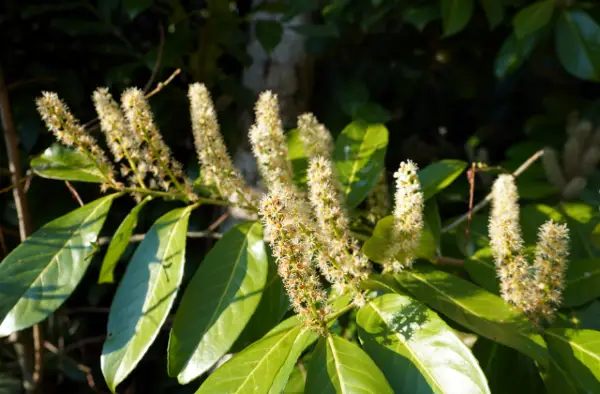Laurel leaves (also known as bay leaves) are widely popular around the globe for their distinctive flavor, soothing aroma, and numerous health benefits. The distinct flavor profile and aromatic significance of laurel leaves are because of generous essential oils. Notably, the Greek and Roman cultures symbolize laurel leaves for triumph, prosperity, and honor.
If you wish to know the nutritional importance and historical significance of laurel leaves, you’ve come to the right place.

Physical Appearance of a Laurel Tree
The Laurel tree has a shrub-like appearance and has glossy, dark green, aromatic Lancelot leaves. These blade-like leaves are about three to twelve centimeters (4.72 inches) long and four centimeters (1.57 inches) wide. The most distinguishing physical characteristic of laurel trees is their pyramidal crown.
In Spring, the tree grows dense clusters of beautiful pale-yellow small flowers. The collection of small laurel flowers measures about one centimeter in diameter, and this pale-yellow bunch of flowers contrast with dark green laurel leaves.

Additionally, it also has small black berries. Laurel trees are easy to grow and can be a great decorative addition to your home garden.
Nutritional Profile of Laurel Leaves
Typically, laurel leaves or bay leaves are used in different cuisines for their signature flavor and fragrance. In addition to bringing an enticing aroma, bay leaves also add unique nutritional value to the dish. On average, two grams of bay leaves contain the following nutrients;
- Calories- 5.5
- Protein- 0.2 gram
- Fats- 0.1 gram
- Carbohydrates- 1.3 grams
- Fiber- 0.5 grams
- Iron- 0.8 milligrams
- Manganese- 0.1 milligrams
Additionally, bay leaves’ distinctive flavor and aroma are due to the presence of 1.8-cineole or eucalyptol essential oil. Other essential oils present in bay leaves are α-terpinyl acetate (4.04-9.87%), terpinene-4-ol (1.33-3.24%), sabinene (4.44-7.75%), β-pinene (2.58-3.91%), α-terpineol (0.95-3.05%), and α-pinene (2.93-4.89%). However, the percentage of 1.8-cineole essential oil is the highest, 51.73-68.48%.
Interesting Facts About Bay Leaves
- Laurel leaves hold significant importance in Roman and Greek cultures. Per these cultures, laurel leaves symbolize peace, protection, and wisdom. In Greek, the word used for Laurus nobilis is Daphne. Daphne is a Greek mythological figure who was the love of one of the most powerful Greek Gods, Apollo.
- Greeks and Romans used to make wreaths using laurel leaves for the people of the highest privilege and honor. Nowadays, the winner of Grand Prix motor racing gets to wear a laurel leaves wreath to symbolize victory.
- Some people believe that laurel leaves inspire spirituality and creativity. Hence, they keep laurel leaves below their pillow to sleep at night, thinking they will wake up with artistic inspiration or ignited spirituality.
- According to the Bible’s scripture, laurel leaves symbolize prosperity, popularity, and success.
- The words’ laureate’ or ‘baccalaureate’ are used for a person who graduated from a college or university originated from laurel. These words are attached to achievement and success, hence the association with the laurel leaf.
Health Benefits of Laurel Leaves
Though it weighs no more than a piece of paper, a laurel leaf has multiple health benefits. Here are a few of the most significant benefits of using laurel leaves in your daily life.
Supports Digestive Health
Bay leaves have long been used to treat digestive health issues, including bloating, stomach aches, and indigestion. There is a need for extensive scientific research to elaborate further on how bay leaves affect your digestive system.
Promotes Urination
Drinking warm water with bay leaves is beneficial for removing toxins from the body. Simultaneously, this process promotes urination and perspiration, helping rinse your body.
Anti-inflammatory and antioxidant Properties
Laurel leaves also exhibit anti-inflammatory and antioxidant properties due to essential oils. The antioxidants present in the bay leaves fight against free radicals, improving overall health. Furthermore, modern research has also shown notable effects of the antimicrobial activities of bay leaves against Salmonella typhimurium and Escherichia coli. Thus, consuming laurel leaves regularly will enhance your body’s immunity against specific bacterial infections.
Another research paper published in 2017 found the antimicrobial effects of essential oils present in the bay leaves were effective against Candida fungal species.
Anticancer Effects
Initial scientific research has revealed positive signs of using bay leaves to reduce cancer cell proliferation. A study published in “Nutrition and Cancer” found the anticancer effect of bay leaf extract for colorectal cancer. More research may reveal this anticancer effect on other cancers as well.
Wound Healing Activity
Numerous research has shown the wound-healing ability of laurel leaves. An animal study published in BMC Complementary and Alternative Medicine revealed that intake of laurel leaves increased the wound closure rate, tensile strength, and the number of inflammatory cells in the tested animals.
Antiviral Activity
Due to the presence of essential oils, including beta-ocimene, 1,8-cineol, alpha-pinene, and beta-pinene, intake of laurel leaves showcases antiviral activity. Specifically, the research has shown that these essential oils from laurel leaves offer antiviral activity against HSV-1 and SARS-CoV replication. Thus, if you wish for protection against COVID and similar viruses, start including bay leaves in your daily meal.
Relieves Stress and Anxiety
In today’s age of hustle and bustle, most of us give little to no importance to our mental health. Therefore, most people suffer from stress, anxiety, and depression. Consumption of laurel leaves can offer you relief from stress and anxiety.
Essential oils are famous for imparting soothing and relaxing vibes within your mind and body. The peculiar aroma and the nutritional essence of laurel leaves may work better than any medication in relaxing your muscles.
Laurel Trees for Planting
Potential Side Effects of Laurel Leaves
People all around the globe use bay leaves for various purposes. In general, there are no side effects from using laurel leaves. However, some people believe that laurel fruits are poisonous. But there is no medical evidence, so it’s more a myth than the truth.
Some people may be allergic to bay leaves. So, they can avoid adding these leaves when cooking.
Some cultures believe that consuming bay leaves can cause abortion, so pregnant women avoid using them. Though no medical proof exists to solidify this statement, it is preferable to use bay leaves per your doctor’s advice.
Laurel may negatively impact your central nervous system (CNS), and this adverse effect may worsen when you consume bay leaves alongside other medications. Therefore, we advise you to avoid self-medication in case of severe health problems and consult a medical practitioner.
For Further Reading
- Beginner’s Guide to Growing Cuban Oregano
- Beginner’s Guide to Growing Stevia
- Popcorn Plant: Surprising Facts You Need to Know
Uses of Laurel Leaves in Routine Life
- Many people use laurel leaves in aromatherapy and potpourri for their unique and distinctive aroma. The beneficial essential oils of these leaves offer calmness and tranquility.
- One of the most popular uses of laurel leaves is in food. People use bay leaves while cooking stews, soups, and gravy items. However, the leaves should be removed while making the final presentation of the dish. Additionally, some people also use these leaves as garnish.
- Dried laurel leaves make delicious and soothing herbal tea. Many prefer this herbal tea to cure the flu and relax muscular tension.
- Many believe that keeping bay leaves in the closet protects clothing from moths and other tiny bugs.
- Some people consider bay leaves an excellent hair care product. They use crushed bay leaves to cure hair loss, improve hair growth, and eliminate dandruff.
How to Store Laurel Leaves
The fully grown bay leaves are dark green, straight, and smooth. Typically, farmers pick the fully grown bay leaves and let them dry in the shade. Drying bay leaves under direct sunlight can denature the chemical composition of natural essential oil, and you won’t be able to gain their potential health benefits.
Later, the dried leaves are sold in the market. In addition to dried bay leaves, some brands also sell dried and crushed spice bay leaf powder. We advise you to choose a reliable and authentic spice market or brand to buy the dried bay leaves.
Storing the bay leaves at home is simple and easy. You can keep the dried leaves in an air-tight jar. It is preferable to place this container in a dark cabinet, safe from direct sunlight. High temperature or humidity can decrease the bay leaves’ quality, flavor, and aroma. If stored properly, you can use dried bay leaves for more than a year. You can use these bay leaves to prepare stews, soups, and gravy items.
Final Words
There you go! We hope you have found this article informative, interesting, and helpful. Laurel leaves are beneficial for maintaining health, and regularly including bay leaves in your diet can help support your immune system and digestive process. The most significant feature of bay leaves is their essential oils.
These essential oils offer antimicrobial, antioxidant, anticancer, and antiviral activities. You can also use the laurel leaves’ essential oil for aromatherapy, muscle relaxation, and relieving stress and anxiety. Many people also massage these essential oils to have a calming sleep.

Darrell has a passion for gardening that he inherited from his father. Go here to read more about the influence his father played in his love for gardening. If you want to send Darrell a quick message, then visit his contact page here.

![How to Water Indoor Plants [Plant Care 101]](https://wraxly.com/wp-content/uploads/2021/03/How-to-Water-Indoor-Plants-Plant-Care-101-1200-1024x576.webp)

![Growing Plants from Cuttings [A Simple Guide]](https://wraxly.com/wp-content/uploads/2021/03/Growing-Plants-from-Cuttings-A-Simple-Guide-1200-1024x576.webp)